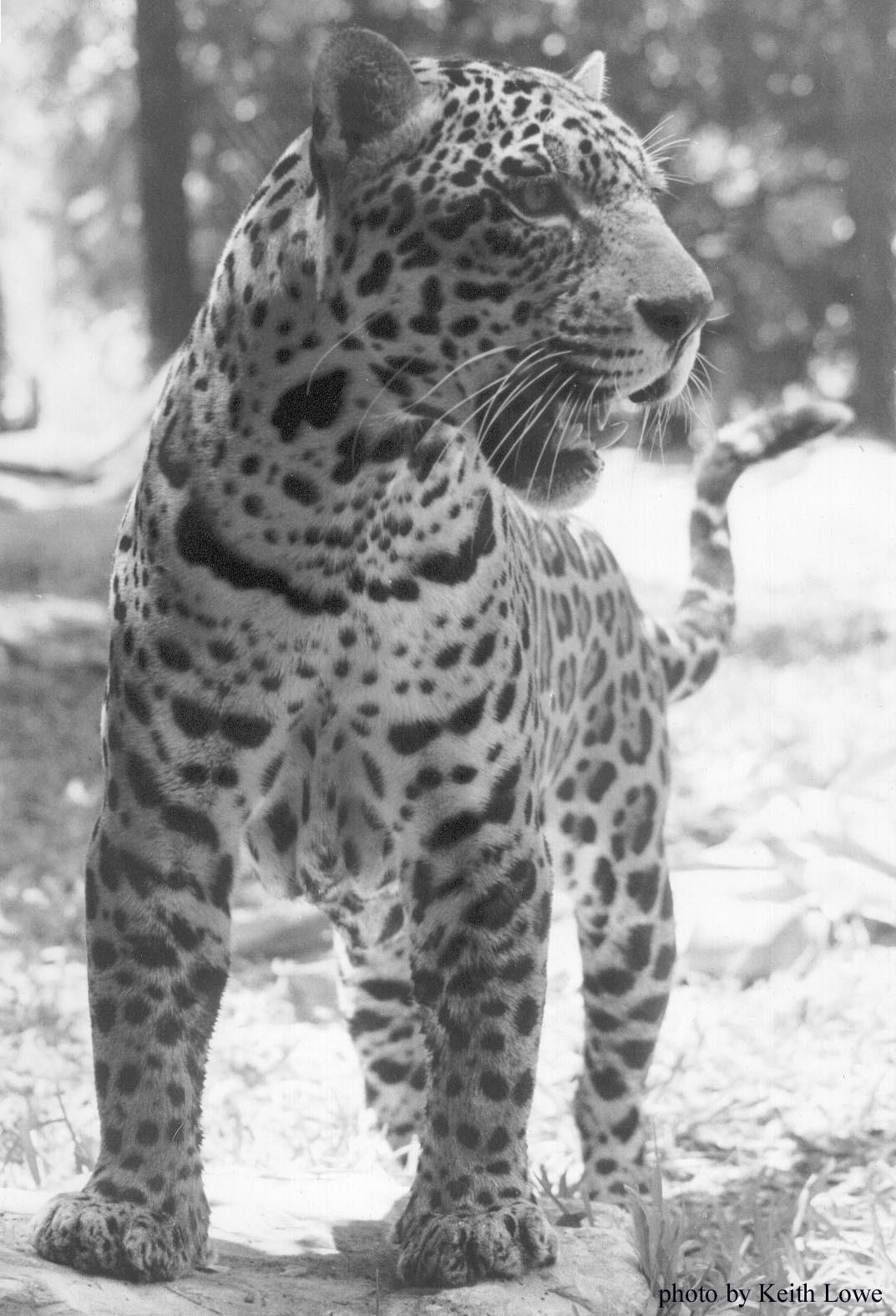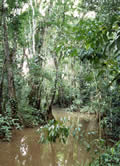Taxonomic
Kingdom-Animalia (Animals)
Phylum-Chordata (Animals with a physically supported
dorsal nerve cord)
Class-Mammalia (Endothermic [warm-blooded] vertebrate
animals with hair, a muscular diaphragm separating
the thoracic and abdominal cavities, that produce
milk and, in most cases, that give live birth
to their young.)
Order-Carnivora (Mammals with dental, sensory
and digestive adaptations specialized for consuming
other animals as prey.)
Family-Felidae (Carnivores with physical and behavioral
adaptations making them identifiable as cats.)
Genus-Panthera (Traditional big cats, with vocal
adaptations allowing them to roar but not purr.
The genus includes lions, tigers, leopards, snow
leopards and jaguars.)
Species-Panthera onca (The only American big cat.)
Physical2,
4
The jaguar is the largest cat in the Americas,
with a record weight of over 347 pounds (158kg).
The largest jaguars have been found in the Brazilian
Pantanal region, where in one study the average
weight of males was 220 pounds (100kg). Head and
body length, without the tail may be up to six
feet (1.85m), and the tail can measure 30 inches
(75cm) more. Height at the shoulder may be up
to 30 inches (75cm).
The jaguar’s coat color ranges from pale
yellow to reddish brown, with a much paler (often
white) underbelly. It has spots on the neck, body
and limbs that form rosettes, which contain black
markings within them. On the head and underparts,
the spots are simple black dots. Black jaguars
are not uncommon, and even they possess darker
rosette markings that are visible in bright light.
Compared to a leopard, the jaguar is stocky and
more powerfully built. The square jaw and prominent
cheeks, along with robust, muscular limbs give
evidence of immense strength. It has been said
that the jaguar is built for power, not speed.
While true, this cat also demonstrates surprising
stealth and grace in movement.
Habitat/Distribution4, 5, 6, 7
First appearing in the fossil record around 2
million years ago, the jaguar has been an American
species at least that long. Found throughout what
is now the southern United States until about
10,000 years ago, it was eliminated from the US
around 1900. In the late 1990s, several sightings
in Arizona occurred, prompting renewed interest
in the jaguar’s northernmost habitat and
distribution. The southern edge of its range is
now in northern Argentina, but once extended into
Uruguay.
Range countries: Argentina, Belize, Bolivia, Brazil,
Colombia, Costa Rica, Ecuador, French Guiana,
Guatemala, Guyana, Honduras, Mexico, Nicaragua,
Panama, Paraguay, Peru, Suriname, United States,
Venezuela. Now extinct in El Salvador and Uruguay.
Habitat is variable for the species. It is found
from lowland jungle to montane forest, at altitudes
of up to 6,500 feet (2,000m) but is seen in wet
grassland and arid scrub as well. A preference
for water seems evident. The jaguar is an excellent
swimmer, and has also been known to patrol ocean
beaches preying on buried sea turtle eggs.
Major habitats include Grassland, Lowland tropical
rainforest, Montane tropical rainforest, Succulent
and thorn scrub, Temperate broadleaf forest, Tropical
monsoon and dry forest, Tropical savannah woodland.
Biology1,
2, 4, 6
The jaguar is a primary predator, at the top of
any ecological community in which it resides.
Capybara and peccaries are usually listed as its
major food source, but tapirs, crocodilians, fish,
snakes, birds and many additional species of small
mammals are taken, too. One probable reason that
the jaguar occurs over such a wide geographic
range, and in a broad variety of habitats is that
it is equipped to exploit large and small prey,
in water and on land. Unlike its African and Asian
cousins, the jaguar is noted for killing prey
via a crushing bite to the skull. Its large canines
and powerful jaws are also able to break open
the shells of turtles and tortoises.
One important cause of the species’ persecution
by humans is its ability to prey on cattle. It
is thought that jaguar populations actually grew
during the period when cattle ranches were first
established in tropical America. For that reason,
many large ranches have employed full-time jaguar
hunters to prevent losses of cattle.
Jaguars are mature at approximately three years
of age. Like tigers and cougars, females seem
to inhabit home ranges of about 15 to 23 mi2 (25
to 38km2). Ranges overlap somewhat, and resident
males inhabit territories about twice that size,
patrolling through the ranges of several females
at a time. Basically solitary, they come together
for breeding. Females have an estrous cycle of
approximately four weeks, and can breed at any
time of year. Gestation is listed as between 93
and 105 days. Litter size is usually fewer than
four cubs. Life expectancy in captivity is among
the longest of any cat, and lifespans of 23 years
have been recorded.
Due, in large part, to much of the jaguar’s
range being inaccessible to researchers, much
remains to be learned about the biology of the
species.
Behavior1,
2, 4, 6
Solitary except when raising cubs, the jaguar
patrols its territory or home range searching
for food. Traditionally thought of as being nocturnal,
radio-collar tracking indicates that jaguars are
active around-the-clock but mostly in the hours
around sunrise and sunset.
An excellent climber, jaguars make good use of
trees. They often drag kills to a secluded or
sheltered spot for consumption but do not cover
or bury them, as cougars do. It has been said
that the jaguar is the only big cat that does
not roar, but this is incorrect. The jaguar has
an array of vocalizations including mews, grunts
and a deep, repetitive “coughing”
roar.
Protection
and Population Status1, 7
The jaguar is listed under CITES (Convention on
International Trade in Endangered Species) Appendix
I. This means that all international trade in
jaguars or their parts is prohibited.
The International Union for the Conservation of
Nature (IUCN) lists jaguars as Lower Risk, near-threatened.
US Fish & Wildlife Service lists jaguars as
Endangered.
Major threats to the species are population fragmentation,
deforestation and deliberate elimination.
Overall the trend in population is a decline.
Specifically in range countries, any hunting of
jaguars is prohibited in Argentina, Colombia,
French Guiana, Honduras, Nicaragua, Panama, Paraguay,
Suriname, United States, Uruguay and Venezuela.
Hunting of jaguars is restricted to “problem
animals” in Brazil, Costa Rica, Guatemala,
Mexico and Peru.
Trophy hunting is permitted in Bolivia.
The species has no legal protection in Ecuador
or Guyana.
Central American populations:
In 1991, Rabinowitz estimated a jaguar population
in Belize of 600 to 1000 animals.
Aranda estimated in 1990 that 125-180 jaguars
were living in Mexico’s 4,000 km2 (2,400
mi2) Calakmul Biosphere Reserve, and additional
465-550 animals in the adjoining Maya Biosphere
Reserve in Guatemala, an area measuring 15,000
km2 (9,000 mi2).
The same researcher has also estimated that some
350 jaguars may be living in several areas of
Chiapas state, Mexico.
South American populations:
The Pantanal is a seasonally flooded wetland covering
more than 100,000 km2 (60,000 mi2) in Brazil,
Bolivia and Paraguay. A rough population density
estimate by Quigley and Crawshaw, in 1992, of
1.4 resident adults per 100 km2 means that only
about 1,400 jaguars may exist in that area.
Population estimates in the Amazon Basin and Orinoco
Basin vary, and are difficult to obtain. In some
regions, jaguars are said to be very common and
in others the species has disappeared completely.
Overall,
it seems that jaguars are not in immediate peril
of extinction. However, their current geographic
range is somewhere between one-third and half
its historical size.
Importance to people

Economic
impact:
Since the implementation of CITES in 1975, legal
international trade in the pelts of spotted cats
has disappeared.
The October, 2001, issue of National Geographic
Magazine quoted cattle ranchers in South
America as claiming that certain herds face losses
of up to 10 percent due to jaguar predation.
The jaguar is often cited as a draw to ecotourism.
However, due to their normally reclusive nature
jaguars are not often seen by tourists. Tour guides
themselves may go years without a sighting. (Eduardo
Nycander, Rainforest Expeditions, personal comment.)
Wildlife in culture8, 9, 10, 11
Jaguars elicit a wide range of responses from
people. Through history they have been both deified
and vilified. The image of the species has been
commercialized more than once. It played an important
and varied role in pre-Columbian American culture.
The Maya had the only written language in the
Americas before European contact. Both verbal
and visual puns played roles in their complex
world-view. The name Xbalanque, one of
their Hero Twins whose exploits before the creation
of humanity explains many natural phenomena, translates
literally as "sun's hidden aspect."
Within his name is a verbal pun on balam,
Classic Mayan for "jaguar." The Jaguar
God of the Underworld, responsible for the sun's
nightly passage beneath the earth, becomes truly
the sun's hidden aspect.
In
Quiche Maya lore, three of the first four humans
were named B'alam K'itze (Jaguar Cedar),
B'alam Aq'ab (Jaguar Night), and Ik'ib'alam
(Dark Jaguar).
As a symbol of royal power, a jaguar pelt was
often worn by kings. Carved stone stelae depict
the presentation of regalia, including helmets
in the shape of a jaguar head. As many as fifteen
sacrificed jaguars have been discovered in Mayan
royal tombs.
Aztec culture also featured animals in art, architecture
and religion. Tezcatlipoca, god of darkness
and evil-doers, was often disguised as a jaguar.
His spotted skin represented the stars in the
night sky. The two highest Aztec military ordres
took as their emblems the top predators of sky
and earth: the Orders of the Eagle and Jaguar.
Shamans in many cultures claim the ability to
change into animal form. Stealthy and powerful,
the jaguar is an often-assumed guise.
References
Printer-friendly
version
You
will need Adobe Reader© to open the file.
This free program may be downloaded from www.adobe.com.
|

